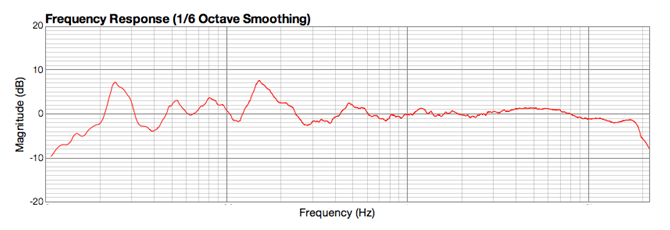| May 1, 2010
Frequency Response Isn’t the Only Thing
Over the past four years or so I’ve measured the
frequency responses of almost 30 loudspeakers in my listening room, the Music Vault, and
the exercise has been a fruitful one. I’ve learned better how loudspeakers interact
with my room; I’ve learned better how to correlate what I hear with the tonal shifts
illustrated by a frequency-response graph; and I’ve become acutely aware of those
aspects of a speaker’s sound that don’t show up in graphs. I think every
reviewer -- and every diehard audiophile -- should measure the speakers he or she
auditions at home. Knowing more about audio reproduction is always better than knowing
less.
A speaker’s frequency-response (FR) plot can tell you
a lot about its sound. The most obvious example is how FR defines tonal balance. If
there’s a rise in the midband (100-1000Hz), then voices will typically sound more
forward in the soundstage and have greater presence. If the very high frequencies (above
10kHz) are rolled off, the sound will lack air and the overall presentation will be
somewhat dull. If there’s a hump in the midbass (60-100Hz) but little in the way of
true low bass (below 40Hz), the sound will be weighty and hard-hitting, but will lack the
foundation that the deepest bass provides. The examples are endless. The key is to
understand how what you see in the graph correlates with what you hear at
your seat. The sound you hear will always be a combination of your loudspeakers’
output and the room’s contribution to and shaping of that output. How these combine
at the listening position is what you hear.
But as anyone knows who’s had any experience with
in-room measurements, while a speaker’s FR plot can tell you a lot about what
you’re hearing, it can’t tell you the whole story. There is a long list of other
sound characteristics that, in my experience, have no correlation with in-room frequency
response: resolution, transparency, soundstaging, imaging, etc. Although a set of anechoic
measurements can get to the bottom of some technical elements, such as distortion,
I’m not aware of any that can tell you exactly how a soundstage will develop in your
room.

Dynaudio Focus 360

Rockport Technologies Arrakis
I can think of no better examples than the two loudspeakers
whose graphs of frequency response appear above. The Rockport Technologies Arrakis
(bottom, in green) and the Dynaudio Focus 360 (top, in red) are two of the most neutral
speakers I’ve ever had in the Music Vault. Both are essentially flat transducers. The
deviations from flat represented in each graph -- the peaks at 25, 160, and 480Hz -- are
room effects. The most notable difference between the two is the Dynaudio’s slight
rise in amplitude from 3 to 7kHz, and the Rockport’s slight recession in the same
region. In each case, if you were to flatten out these few room modes, you’d be left
with an essentially neutral loudspeaker.
Although the FR plots above are almost perfect overlays of
each other, anyone who’s heard both speakers in my room will tell you that these two
speakers sound very different. Although both could be accurately described as
having a neutral tonal balance, there is no comparison between them when it comes to their
resolutions of detail across the audioband, their degrees of transparency to the original
recording, the width and depth of their soundstages, their bass articulation and overall
bass power, their midrange texture, etc. The Rockport Arrakis is simply superior in all of
those areas, and by large margins.
In-room frequency response should not be a contentious
issue. Conducting these measurements should not be a threat to the belief systems of
audiophiles. I’m confident that in-room FR can be kept in the proper perspective;
it’s just one of the tools that can help you understand the sound you’re
hearing -- by no means will it tell you everything. But if your goal is to bring
high-fidelity sound to your listening room, it will be wise to not ignore any of
the pieces of the hi-fi puzzle, each of which helps to complete the sonic picture and
bring it into even sharper focus. The music you love to hear literally depends on it.
. . . Jeff Fritz
jeff@ultraaudio.com
|